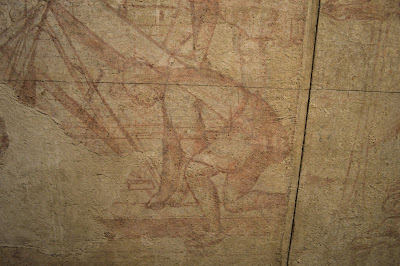A lucky coincidence for medieval woodworkers is that that
the bible contains some stories on building, e.g. Noah's ark and the tower
of Babel, or the construction of the cross. Furthermore there are several Saints that met a gruesome death
with a woodworking tool (Simon with a saw, Matthew with a axe). It is no surprise that some of these scenes were popular as well in fresco cycles in Italy. Previous post showed the building of Noah's ark in the Camposanto in Pisa. Noah's ark was also painted on walls of some other Italian churches.
Florence (Firenze), Santa Maria Novella
The front of the Basilica Santa Maria Novella in Firenze.
The Santa Maria Novella is a church of the Dominican order connected to a
large cloister complex, some parts with very lovely medieval frescoes.
Church building began in the 13th century and was consecrated in 1420.
In the 16th century and later in the 19th century the church was
remodelled. The medieval fresco showing the building of Noah's ark,
however, is detached from its original wall in the green cloister and now hanging in the
museum inside the complex. The damaged fresco was painted by someone in the circle of Paolo Uccello, a Florentine painter and mathematician, around 1430.
Inside the museum, the fresco containing the building of Noah's ark from around 1430.
A two-handed large plane, with the typical Italian open handles.
A detail from the fresco: an auger being used.
San Gimignano, Collegiate Church of Santa Maria Assuntais

Many frescoes and even more tourists in the Collegiate Church of Santa Maria Assuntais in San Gimignano.
San Gimignano, the medieval city with its many towers; a lovely place, but swarming with too many tourists - one was me. The Collegiate Church of Santa Maria Assuntais located in the main square of the town and is part of the UNESCO World Heritage Site. The Romanesque style church dates largely from the 12th and 13th century, but with parts added in the next centuries. The church is most famous for its largely intact scheme of fresco decoration, the greater part of which dates from the 14th century. The wall of the left aisle had six decorated bays with frescoes containing stories from the old testament that are the work of Bartolo di Fredi, and were completed around 1356. One of these is that of Noah and his family building the ark.

Noah building the ark by Bartolo di Fredi around 1356.
On the roof are three people busy with clawhammers and an auger.

Below several axes and adzes are being used.
A man using the plane is offered a drink.

From the wall on the other side of the church, Christ bearing the cross,
and another one bearing a clawhammer and nails.
Siena, Palazzo Pubblico
The Palazzo Pubblico in Sienna with preparations for the palio race.
The Palazzo Pubblico is Siena's medieval administrative building on the
main square of the city where also the horse races take place. It was
built in the 13th and 14th century, and the large bell tower contains a
14th century mechanical clock. Nearly every major room in the palace
contains frescoes. The medieval frescoes on the walls inside the
building were meant to impress the visitor of the power and goodness of
the city. Two frescoes containing woodworking tools - the allegories of
good and bad government - by Ambrogio Lorenzetti can be found in the
Sala della Pace.
Part of the allegory of good government fresco in the Palazzo Pubblico.
The Allegory of Good Government contains a large plane with the name
'Concordia' on it. The plane is a typical example of the Italian
medieval planes, but also unusual as the wedge holding the iron seems to
consist of two separate wedges. Could it be that one wedge serves as a
chip-breaker? In the allegory of Bad Government a large frame saw can be seen.
The concordia plane contains a typical double wedge.
Part of the allegory of bad government frescoin the Palazzo Pubblico.
A large frame saw being used on something unknown.
Some more frescoes
Below are two more frescoes containing scenes from building Noah's Ark from elsewhere in Italy (and not visited by me). It is likely that many more of these frescoes with woodworking tools are hidden in other not so famous medieval churches in Italy.
Basilica of San Francesco, Assisi, Italy, upper vault,
painted between 1288-1300, likely by Giotto. Image from internet.

Fresco from the vault of stairs of the Chiesa di San Lorenzo in Palatio, Rome, Italy
by Baldassare Croce (1558 - 1628). Image from internet.
















































